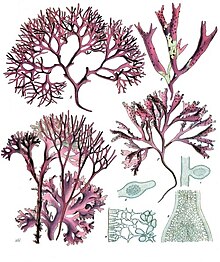| Carageen | |
|---|---|

| |
| A-D Chondrus crispus ; E-F Mastocarpus stellatus | |
| Scientific classification | |
| Clade: | Archaeplastida |
| Division: | Rhodophyta |
| Class: | Florideophyceae |
| Order: | Gigartinales |
| Family: | Phyllophoraceae |
| Genus: | Mastocarpus |
| Species: | M. stellatus
|
| Binomial name | |
| Mastocarpus stellatus (Stackhouse) Guiry
| |
| Synonyms | |
|
Gigartina stellata | |
Mastocarpus stellatus, commonly known as carrageenan moss or false Irish moss,[1] is a species in the Rhodophyceae division, a red algae seaweed division, and the Phyllophoracea family. M. stellatus is closely related to Irish Moss (Chondrus crispus). It grows in the intertidal zone. It is most collected in North Atlantic regions such as Ireland and Scotland, together with Irish moss, dried, and sold for cooking and as the basis for a drink reputed to ward off colds and flu. Marine biologists have completed studies on the medicinal reputation of M. stellatus to discover the full potential of its pharmaceutical benefits. Additionally, marine biologists have conducted research on its potential to serve as an alternative to plastic. The application of M. stellatus in these different industries is correlated with the seaweed's adaptations which developed in response to the environmental stressors present around its location on the rocky intertidal.

- ^ Blanco-Pascual, N.; Gómez-Guillén, M.C.; Montero, M.P. (2014-10-01). "Integral Mastocarpus stellatus use for antioxidant edible film development". Food Hydrocolloids. 40: 128–137. doi:10.1016/j.foodhyd.2014.02.013. ISSN 0268-005X.